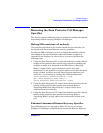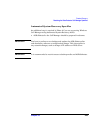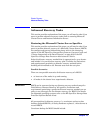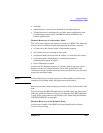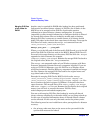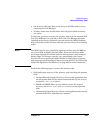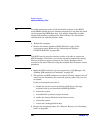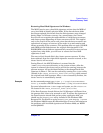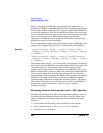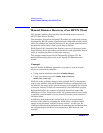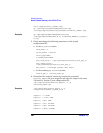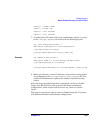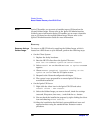
Disaster Recovery
Advanced Recovery Tasks
Chapter 10 495
Restoring Hard Disk Signatures On Windows
The MSCS service uses a hard disk signature written into the MBR of
every hard disk to identify physical disks. If the shared cluster disks
have been replaced, this means that the disk signatures were changed
during Phase 1 of disaster recovery. As a consequence, the Cluster
Service will not recognize the replaced disks as valid cluster resources,
and cluster groups depending on those resources will fail. This applies
only to the restore of the active node, since shared cluster resources are
operational as long as at least one of the nodes is up and running and
claims ownership of the resources. This problem does not apply to EADR
and OBDR critical disks because the original disk signatures of all
EADR/OBDR critical disks are automatically recovered. In case you have
replaced any other disks, you will have to restore their hard disk
signatures as well.
The most critical shared disk is the cluster quorum resource. If it has
been replaced, than the original disk signature must be restored, or the
cluster service will not start.
During Phase 2, the MSCS Database is restored into the
\TEMP\ClusterDatabase directory on the system volume. After the
system is rebooted, the cluster service will not be running, because the
quorum resource will not be identified due to the changed hard disk
signature in Phase 1. This can be resolved by running the clubar utility
(located in the <Data_Protector_home>\bin\utilns), which restores
the original hard disk signature. After clubar successfully finishes, the
cluster service is automatically started.
Example At the command prompt type clubar r c:\temp\ClusterDatabase
force q: to restore a MSCS Database from c:\temp\ClusterDatabase.
For more information on clubar usage and syntax, see the clubar.txt
file located in the <Data_Protector_home>\bin\utilns.
If the Data Protector shared disk on the Cell Manager is different from
the quorum disk, it has to be restored as well. To restore the signature of
the Data Protector shared disk and any other application disk, you
should use the dumpcfg.exe utility included in the Windows 2000
Resource Kit. For details on using dumpcfg.exe, run dumpcfg /? or see
the Windows 2000 Resource Kit documentation. For more information on
the problems with hard disk signatures on Windows 2000, see MSDN
article Q280425.



